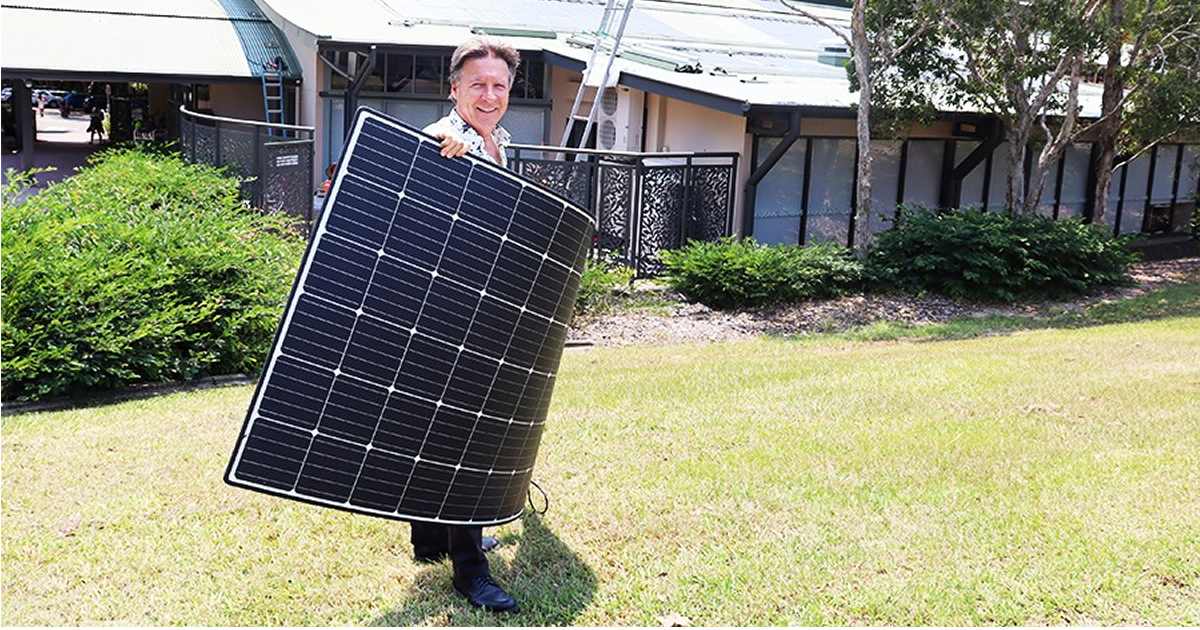
Image: Noosa Shire Council
Literally demonstrating how flexible PV technology can be, Noosa Shire Council’s latest solar installation is based on flexible solar panels.
The curved rooftop of the library in Noosaville is now sporting a 72.5-kilowatt system comprised of 250 eArche solar panels. The 290 watt modules weigh just 5.5 kilograms each, compared to conventional glass-faced panels weighing in at around 18-19 kilograms. The modules were fixed to Noosaville Library’s roof using a special adhesive.
“The installation was less labour-intensive than traditional glass panels,” said Noosa Shire Mayor Tony Wellington. “The non-glass panels also perform better in extreme weather conditions such as hail. With the summer storm season upon us, the timing couldn’t be better.”
By “perform better”, it’s assumed Mayor Wellington was referring to less risk of damage from hail.
More About eArche Solar Panels
eArche panels are produced by Sunman (Zhenjiang) Company Limited (SunMan Energy), whose founder and chief technology officer is Shi Zhengrong – a man once dubbed the “Sun King” and who founded another solar panel manufacturer, Suntech.
The modules are based on monocrystalline PERC cells and are available in framed and non-framed versions.
Here’s Dr. Shi Zhengrong chatting about the eArche solar panels back in August:
The datasheet for the 290W eArche indicates a module efficiency of 17.1% and a temperature coefficient of Pmax of -0.38 %/°C1
As well as curved rooftops, lightweight flexible solar panels such as the eArche have applications in commercial solar installations where a roof has been constructed to minimum specifications – what’s known as a “slender roof“. Slender roofs may be unable to support the weight of a conventional solar panel array.
eArche panels appear to be significantly more costly than conventional modules. I saw 290W eArche solar panels with a thin frame advertised in Australia for $495 (retail), but wasn’t able to locate any pricing on the 290W frameless version. While more expensive, in a slender roof situation it may prove to be cheaper to use the eArche than to carry out roof strengthening work.
Other significant eArche installations in Australia include a 235 kW system recently installed on the rooftop of Australian National Maritime Museum’s Heritage Centre, which is an example of a slender roof installation. eArche solar panels were also used for Byron Bay’s solar train.
Another Step Towards Carbon Neutrality For Noosa
Noosa Shire Council has made a commitment to be carbon neutral by 2026, with solar energy playing an important role in achieving that goal.
The Noosaville Library project joins nine other council facilities that have significant solar power installations. Among buildings to get (more) PV capacity is the Tewantin Administration Building.
Mayor Wellington said some of the current installations are slashing mains grid electricity consumption by up to 80 per cent and the Noosaville Library project is expected to generate equivalent to half of the facility’s electricity needs.
In July this year, Noosa Shire Council became the first Queensland local government to declare a climate emergency. The declaration movement has continued to gain momentum since that time – 76 jurisdictions across Australia representing approximately 6.6 million people had declared a climate emergency by the end of last month.
Footnotes
- Temperature coefficient of Pmax indicates how much power is lost for every °C the panel is hotter than 25°C. ↩

 RSS - Posts
RSS - Posts



Hello. I’m new to this tech, i thought that the thin style stick on panels need air flow around them to work well. With this and another article on high wind speeds it doesnt mention this point. Can ypu elaborate please.
Any solar panel will work slightly better if air can circulate around it and help keep its temperature down. But in a situation where weight has to be kept to a minimum, using lightweight panels that are glued on and have very limited or no air circulation can be better than the alternative of not being able to install solar panels at all.